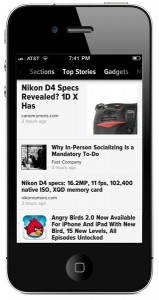If you’re like most smartphone users, you’re killing time by browsing while you wait for… well, anything. The death of free time has resulted in a new optimization problem opportunity.

When I’m waiting I usually pull up Zite. It’s my go to content curation tool of the moment. I then walk through a fairly complex set of steps to share interesting stories that I find. The interesting part is that on some sites I am sending people to a mobile web page because the story I’m viewing is being served up to me on my iPhone.
What that means to you is that more and more people are going to be sending traffic to your mobile site. You may have thought through the idea that you should check incoming visitors to your main site to see if they are on a mobile device, but are you checking for the opposite?
Today I shared a link to an interesting story at C|Net about the growth of Google Chrome and what that means to Facebook. I saw the story on Zite (on my phone), clicked through and read about 1/4 of it, then opened it in Safari and finally shared it through the Buffer bookmark. The url that I shared was http://m.cnet.com/Article.rbml?nid=57414140. That’s the mobile version of the story. C|Net is smart enough that when I browse to that url on my laptop it redirects me to their full page at http://news.cnet.com/8301-33617_3-57414140-276/why-facebook-needs-to-build-a-browser/. Smart.
I also shared a link yesterday to my new friend (and Twitter Tournament opponent) Jim Sterne’s article over at ClickZ on his distaste of the term “actionable analytics”. That link went to http://m.clickz.com/clickz/column/2166558/actionable-analytics. That link does not redirect to the full site when you browse to that address on a laptop. The ClickZ page adds the noindex robots meta tag to their mobile page, but it doesn’t canonicalize back to their main site’s page. The full site has the rel=canonical tag but not the mobile site.
Both Bing and Google want you to move to a single url strategy. They would love you to use some method of adaptive/responsive design so that the same url is served to everyone. If that’s not possible for you right now, then the next best solution is to do some smart user-agent sniffing and give people what they need where they need it. If you are running that on different hosts (m. vs. www) make sure that you use the rel=canonical tag to let the search engines know where you want any of the link juice you gather to be dropped off.
For more about the amazing content-curation app Zite, see our review “The Best Search Engines Today Aren’t Search Engines“








